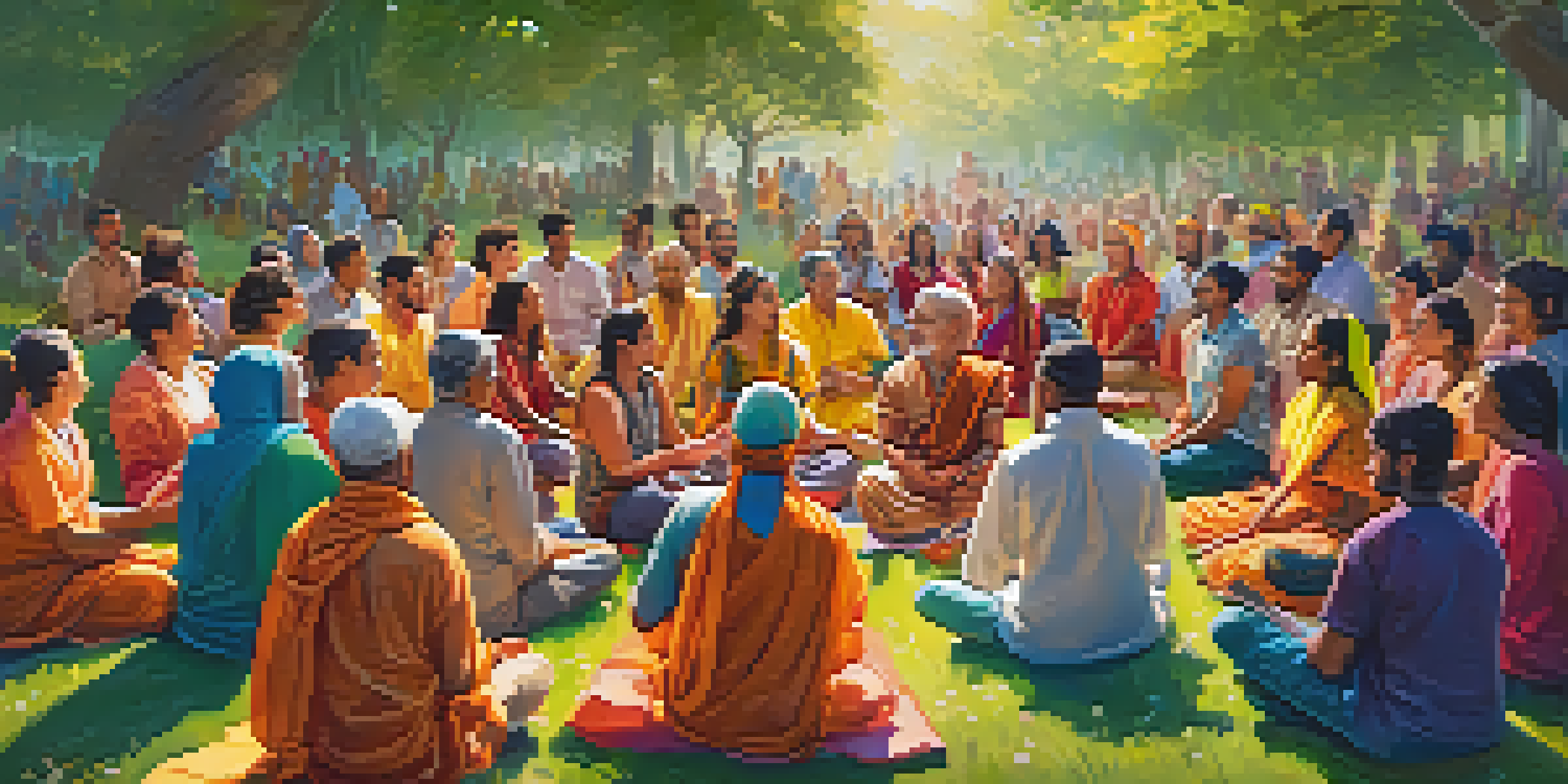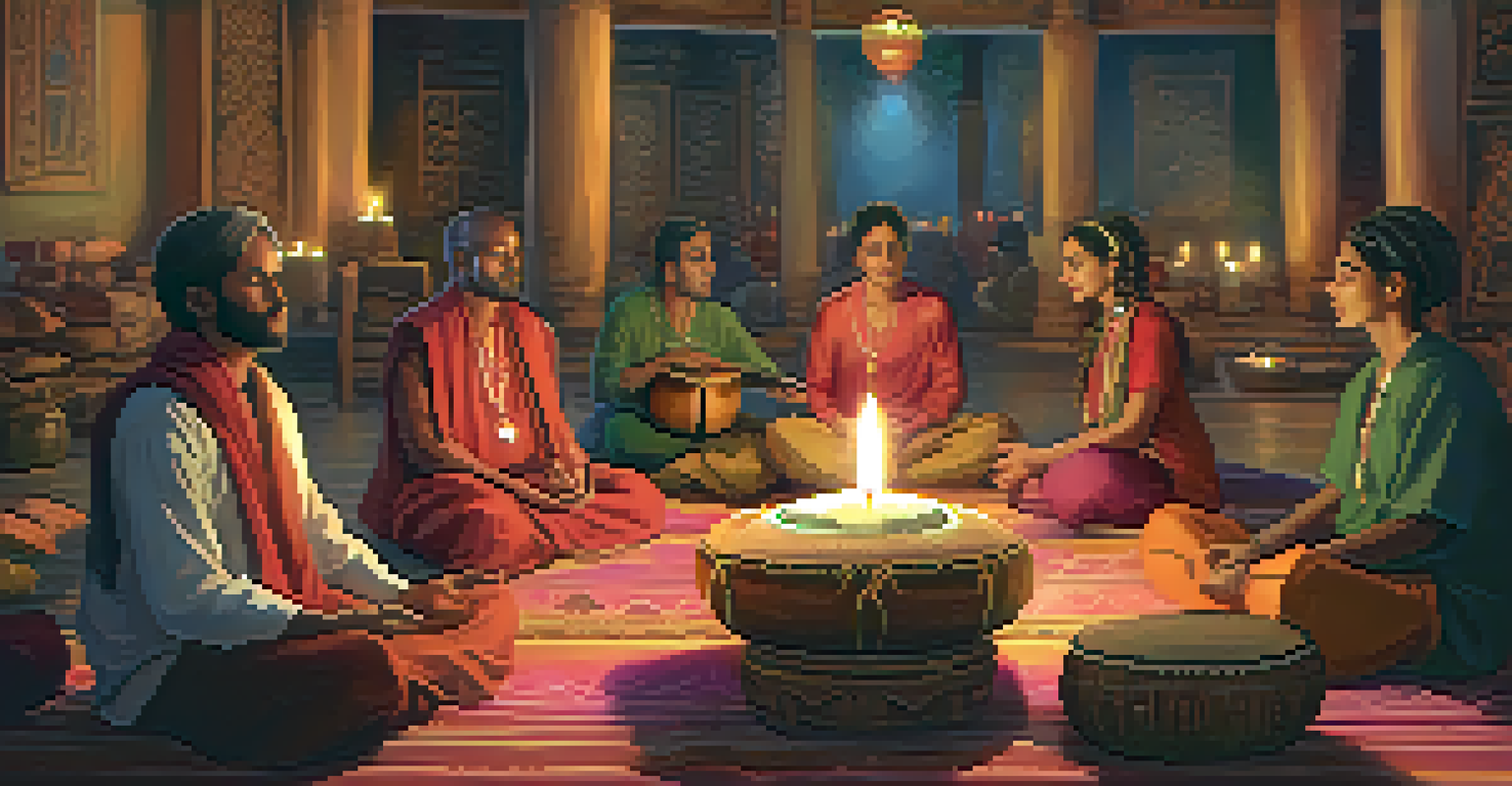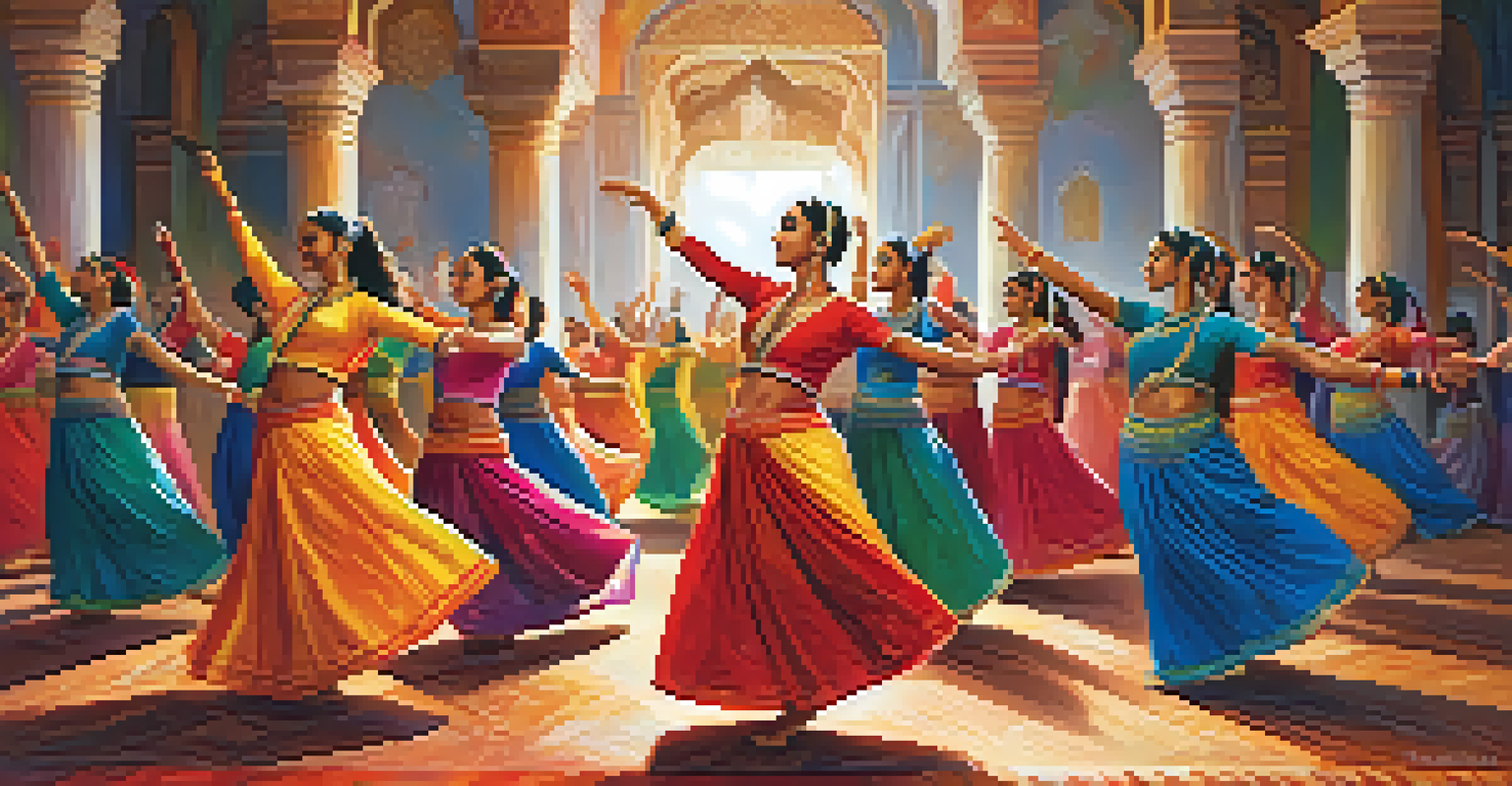Kirtan and Dance: Healing Through Music and Movement in India

Understanding Kirtan: The Essence of Devotional Music
Kirtan is a form of devotional chanting that originated in India, often involving call-and-response singing. It's not just about the music; it's a spiritual practice that helps devotees connect with the divine. Through the repetition of mantras and songs, participants enter a meditative state, allowing them to experience a sense of peace and oneness.
Music can change the world because it can change people.
The melodies and rhythms of Kirtan vary widely, reflecting the rich tapestry of Indian musical traditions. Each Kirtan session creates a unique atmosphere, drawing people into a collective experience that transcends individual worries and stress. This communal aspect of Kirtan fosters a deep sense of belonging among participants.
In essence, Kirtan serves as a powerful tool for emotional and spiritual healing, allowing individuals to express their feelings and find solace in the shared experience of music. Whether you're a seasoned practitioner or a newcomer, Kirtan invites you to explore your inner world and connect with others on a profound level.
The Role of Dance in Enhancing Kirtan Experiences
Dance is an intrinsic part of many Kirtan sessions, adding a dynamic element that enhances the overall experience. As the music plays, participants often feel compelled to move, allowing their bodies to express the emotions stirred by the chants. This movement creates a sense of freedom and joy, amplifying the healing effects of the music.

Incorporating dance into Kirtan not only deepens the connection to the music but also encourages physical expression. It transforms the space into a vibrant celebration where participants can let go of their inhibitions and immerse themselves in the moment. This blend of music and movement fosters an atmosphere of unity and exuberance.
Kirtan: A Spiritual Musical Journey
Kirtan serves as a powerful spiritual practice that fosters emotional healing through communal chanting and music.
Moreover, dance can serve as a form of meditation, as focusing on movement allows individuals to quiet their minds and engage fully with their bodies. This holistic approach to Kirtan encourages a complete release of tension and fosters emotional healing, making every session a cathartic experience.
Healing Through Rhythm: The Science Behind Music and Movement
Research has shown that music and movement have profound effects on our mental and emotional well-being. Engaging in rhythmic activities like Kirtan and dance releases endorphins, which are the body's natural feel-good chemicals. This biochemical response helps to alleviate stress and anxiety, creating a sense of euphoria and relaxation.
Dance is the hidden language of the soul.
Additionally, the communal aspect of Kirtan, combined with rhythmic movement, fosters social bonding, which is essential for emotional health. When people gather to share in music and dance, they create connections that can uplift their spirits and combat feelings of loneliness. This collective energy is often palpable, making the healing experience even more profound.
In essence, participating in Kirtan and dance can lead to a transformative healing process. The combination of music, movement, and community creates a powerful synergy that nurtures the body, mind, and spirit.
Cultural Significance of Kirtan and Dance in India
Kirtan and dance are deeply rooted in India's cultural and spiritual heritage. They are often performed during religious festivals, celebrations, and community gatherings, serving as a way to honor deities and express devotion. These practices have been passed down through generations, embodying the rich traditions of Indian spirituality and artistry.
Each region in India brings its unique flavor to Kirtan and dance, showcasing diverse musical styles and dance forms. From the graceful movements of classical dance to the energetic beats of folk dances, there is a vibrant tapestry of expression that reflects the local culture. This diversity enriches the Kirtan experience, inviting participants to explore various artistic traditions.
Dance Enhances Kirtan Experience
Incorporating dance into Kirtan amplifies joy and freedom, transforming the experience into a vibrant celebration of movement and music.
Ultimately, Kirtan and dance are not just forms of entertainment; they are vital expressions of community and spirituality that contribute to the collective identity of Indian society. They remind us of the importance of connection, creativity, and shared experiences in our healing journeys.
Kirtan and Dance: A Path to Personal Healing
For many individuals, engaging in Kirtan and dance offers a personal path to healing and self-discovery. The act of singing and moving allows one to release pent-up emotions, fostering a sense of catharsis. Participants often report feeling lighter and more centered after a session, as if a weight has been lifted from their shoulders.
Moreover, the repetitive nature of Kirtan can help individuals process their thoughts and feelings. As they immerse themselves in the music, they may find clarity and insight into personal challenges. This reflective aspect of Kirtan provides an opportunity for self-exploration and growth, making it a powerful tool for personal development.
Ultimately, the journey of healing through Kirtan and dance is a deeply personal one. Each participant may find their unique connection to the music and movement, leading to transformative experiences that resonate long after the session has ended.
Finding Community Through Kirtan and Dance
One of the most beautiful aspects of Kirtan and dance is the sense of community they foster. When individuals come together to chant and move, they create a shared space filled with love, acceptance, and support. This communal energy is vital for healing, as it reminds participants that they are not alone in their struggles.
Through regular participation in Kirtan and dance, people often develop lasting friendships and connections. These relationships can provide a support system that extends beyond the music, allowing individuals to share their journeys and uplift one another. The bonds formed in these spaces can be incredibly healing and nurturing.
Community Connection Through Kirtan
Participating in Kirtan and dance builds a sense of belonging and support, creating lasting friendships that nurture emotional well-being.
In essence, Kirtan and dance serve as a bridge between individuals, creating a sense of belonging that is essential for emotional well-being. The community built around these practices is a testament to the power of music and movement in bringing people together for healing and joy.
Experiencing Kirtan and Dance: How to Get Involved
If you're interested in exploring Kirtan and dance, many communities around the world offer sessions you can join. Whether you're a seasoned practitioner or a complete beginner, there's a welcoming space for you to experience the healing power of music and movement. Look for local events, workshops, or online sessions that resonate with you.
Participating in Kirtan and dance doesn't require any prior experience or expertise. The focus is on connection and expression, allowing you to engage in a way that feels comfortable. Allow yourself to be present, let go of judgment, and embrace the experience wholeheartedly. You may find that the music and movement unlock something within you.

Ultimately, the journey into Kirtan and dance is an invitation to explore a world of healing and community. As you step into this vibrant practice, you may discover new dimensions of joy, connection, and personal growth that enrich your life.